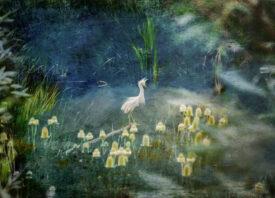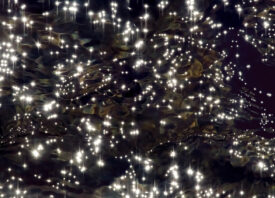Search this site
Vancouver’s “Mothpocalypse” Highlights the Fragility of Our Planet


“Some people called in a moth outbreak,” Shira Gold tells me. “Others, a pandemic.” She’s talking about a smaller, local event that took place at roughly the same time as the Covid pandemic: in the summer of 2020, the population of Western hemlock looper moths in Vancouver soared as part of a natural, three-year “outbreak cycle.” The cycle repeats every eleven to fifteen years, depending on environmental conditions.
Throughout the outbreak, the photographer saw moths populate the city; she noticed them in the trees and close to the lights. But Gold truly came face-to-face with what some dubbed the “Mothpocalypse” while visiting Rice Lake in North Vancouver: to her astonishment, the surface of the water was shrouded in the delicate insects. “They covered the lake like an ornate lace cloth,” she remembers. “There must have been hundreds of thousands, often laying wing-to-wing. There were no sounds, just stillness. Visual stillness. Audible stillness. They had all died.”
It was sad, and it was beautiful. It took her breath away. In the background, around the world, another pandemic raged. Millions of people would be killed by the coronavirus by the time the moths returned the next summer.
Gold, like many of us, navigated a year of shifting rules and regulations, walking a tightrope of uncertainty and fear. She felt pulled in all directions. All the while, she couldn’t stop thinking about the moths on the lake, haunting and ethereal. The insects symbolized the preciousness and fragility of life, but more than that, they came to represent “our universal desire to seek light in the midst of darkness.” Moths, like butterflies, are symbols of adaption, renewal, and survival.
By A Thread was born of those quiet and lonely months. The photographs themselves are c composites, created with photographs made at Rice Lake. She gathered materials, including cocoons and silk threads made by The Silk Weaver Studio on Granville Island, Vancouver. She arranged them on her scanner, along with sewing threads, and then she painstakingly put the final images together in Photoshop, using both scanned and photographed elements.
“I knew there needed to be severe linear and inorganic lines that the moths were almost strung from, hung on by, or escaping from,” Gold explains. “There were so many references to lines during this time: ‘tow the line,’ ‘walk the line,’ ‘hold the line,’ ‘wait in line,’ and, of course, stand between the two lines, six feet apart.” The cocoons came to represent the idea of home–safe and warm but also easily breached or endangered.
Gold worked when her kids were in online classes or after they went to bed. She says making the images was like putting together a large puzzle using many tiny pieces. It was also therapeutic. Making pictures helped her cope. “I have always found that in times of extreme struggle and transition, in grief and in growth, we can see the most beauty if we are open to it,” the artist says. She released the series on the day the pandemic-related restrictions were lifted. It was time.
The “moth pandemic” is now over. Western hemlock looper moths are native to British Columbia, and the moth outbreak is a natural occurrence that benefits the surrounding landscape. But scientists say that climate change is likely to make them more frequent and intense, and those changes will have a ripple effect across the ecosystem. In 2021, for example, a drought hit parts of B.C, and extreme heat put increased pressure on trees in the area.
Gold photographed all the moths in situ, never moving them from the surface of the lake. I asked her why she didn’t bring any of them home with her to photograph in the studio, along with the thread and cocoons. “The landscape of their resting place felt very sacred,” she tells me. “Interrupting that wasn’t something I considered.” The next Western hemlock looper moth outbreak cycle won’t happen for at least a decade. It’s expected to arrive between 2032 and 2036.







All images © Shira Gold



